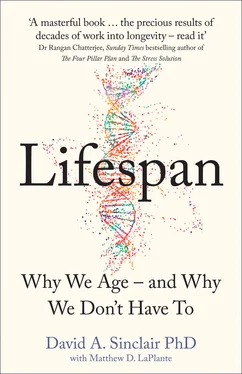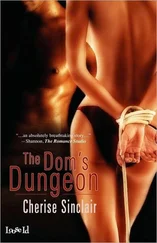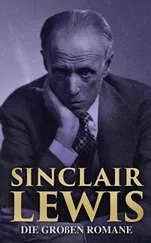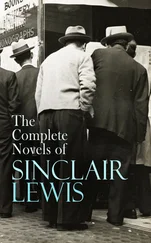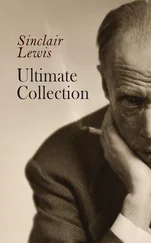CRISIS MODE
Wilbur and Orville Wright could never have built a flying machine without a knowledge of airflow and negative pressure and a wind tunnel. Nor could the United States have put men on the moon without an understanding of metallurgy, liquid combustion, computers, and some measure of confidence that the moon is not made of green cheese. 7
In the same way, if we are to make real progress in the effort to alleviate the suffering that comes with aging, what is needed is a unified explanation for why we age, not just at the evolutionary level but at the fundamental level.
But explaining aging at a fundamental level is no easy task. It will have to satisfy all known laws of physics and all rules of chemistry and be consistent with centuries of biological observations. It will need to span the least understood world between the size of a molecule and the size of a grain of sand, 8and it should explain simultaneously the simplest and the most complex living machines that have ever existed.
It should, therefore, come as no surprise that there has never been a unified theory of aging, at least not one that has held up—though not for lack of trying.
One hypothesis, proposed independently by Peter Medawar and Leo Szilard, was that aging is caused by DNA damage and a resulting loss of genetic information. Unlike Medawar, who was always a biologist, who built a Nobel Prize–winning career in immunology, Szilard had come to study biology in a roundabout way. The Budapest-born polymath and inventor lived a nomadic life with no permanent job or address, preferring to spend his time staying with colleagues who satisfied his mental curiosities about the big questions facing humanity. Early in his career, he was a pioneering nuclear physicist and a founding collaborator on the Manhattan Project, which ushered in the age of atomic warfare. Horrified by the countless lives his work had helped end, he turned his tortured mind toward making life maximally long. 9
The idea that mutation accumulation causes aging was embraced by scientists and the public alike in the 1950s and 1960s, at a time when the effects of radiation on human DNA were on a lot of people’s minds. But although we know with great certainty that radiation can cause all sorts of problems in our cells, it causes only a subset of the signs and symptoms we observe during aging, 10so it cannot serve as a universal theory.
In 1963, the British biologist Leslie Orgel threw his hat into the ring with his “Error Catastrophe Hypothesis,” which postulated that mistakes made during the DNA-copying process lead to mutations in genes, including those needed to make the protein machinery that copies DNA. The process increasingly disrupts those same processes, multiplying upon themselves until a person’s genome has been incorrectly copied into oblivion. 11
Around the same time that Szilard was focusing on radiation, Denham Harman, a chemist at Shell Oil, was also thinking atomically, albeit in a different way. After taking time off to finish medical school at Stanford University, he came up with the “Free Radical Theory of Aging,” which blames aging on unpaired electrons that whiz around within cells, damaging DNA through oxidation, especially in mitochondria, because that is where most free radicals are generated. 12Harman spent the better part of his life testing the theory.
I had the pleasure of meeting the Harman family in 2013. His wife told me that Professor Harman had been taking high doses of alphalipoic acid for most of his life to quench free radicals. Considering that he worked tirelessly on his research well into his 90s, I suppose, at the very least, it didn’t hurt.
Through the 1970s and 1980s, Harman and hundreds of other researchers tested whether antioxidants would extend the lifespan of animals. The results overall were disappointing. Although Harman had some success increasing the average lifespan of rodents, such as with the food additive butylated hydroxytoluene, none showed an increase in maximum lifespan. In other words, a cohort of study animals might live a few weeks longer, on average, but none of the animals was setting records for individual longevity. Science has since demonstrated that the positive health effects attainable from an antioxidant-rich diet are more likely caused by stimulating the body’s natural defenses against aging, including boosting the production of the body’s enzymes that eliminate free radicals, not as a result of the antioxidant activity itself.
If old habits die hard, the free-radical idea is heroin. The theory was overturned by scientists within the cloisters of my field more than a decade ago, yet it is still widely perpetuated by purveyors of pills and drinks, who fuel a $3 billion global industry. 13With all that advertising, it is not surprising that more than 60 percent of US consumers still look for foods and beverages that are good sources of antioxidants. 14
Free radicals do cause mutations. Of course they do. You can find mutations in abundance, particularly in cells that are exposed to the outside world 15and in the mitochondrial genomes of old individuals. Mitochondrial decline is certainly a hallmark of aging and can lead to organ dysfunction. But mutations alone, especially mutations in the nuclear genome, conflict with an ever-increasing amount of evidence to the contrary.
Arlan Richardson and Holly Van Remmen spent about a decade at the University of Texas at San Antonio testing if increasing free-radical damage or mutations in mice led to aging; it didn’t. 16In my lab and others, it has proven surprisingly simple to restore the function of mitochondria in old mice, indicating that a large part of aging is not due to mutations in mitochondrial DNA, either, at least not until late in life. 17
Although the discussion about the role of nuclear DNA mutations in aging continues, there is one fact that contradicts all these theories, one that is difficult to refute.
Ironically, it was Szilard, in 1960, who initiated the demise of his own theory by figuring out how to clone a human cell. 18Cloning gives us the answer as to whether or not mutations cause aging. If old cells had indeed lost crucial genetic information and this was the cause of aging, we shouldn’t be able to clone new animals from older individuals. Clones would be born old.
It’s a misconception that cloned animals age prematurely. It has been widely perpetuated in the media and even the National Institutes of Health website says so. 19Yes, it’s true that Dolly, the first cloned sheep, created by Keith Campbell and Ian Wilmut at the Roslin Institute at the University of Edinburgh, lived only half a normal lifespan and died of a progressive lung disease. But extensive analysis of her remains showed no sign of premature aging. 20Meanwhile, the list of animal species that have been cloned and proven to live a normal, healthy lifespan now includes goats, sheep, mice, and cows. 21
Because of the fact that nuclear transfer works in cloning, we can say with a high degree of confidence that aging isn’t caused by mutations in nuclear DNA. Sure, it’s possible that some cells in the body don’t mutate and those are the ones that end up making successful clones, but that seems highly unlikely. The simplest explanation is that old animals retain all the requisite genetic information to generate an entirely new, healthy animal and that mutations are not the primary cause of aging. 22
It’s certainly no dishonor to those brilliant researchers that their theories haven’t withstood the test of time. That’s what happens to most science, and perhaps all of it eventually. In The Structure of Scientific Revolutions , Thomas Kuhn noted that scientific discovery is never complete; it goes through predictable stages of evolution. When a theory succeeds at explaining previously unexplainable observations about the world, it becomes a tool that scientists can use to discover even more.
Читать дальше
